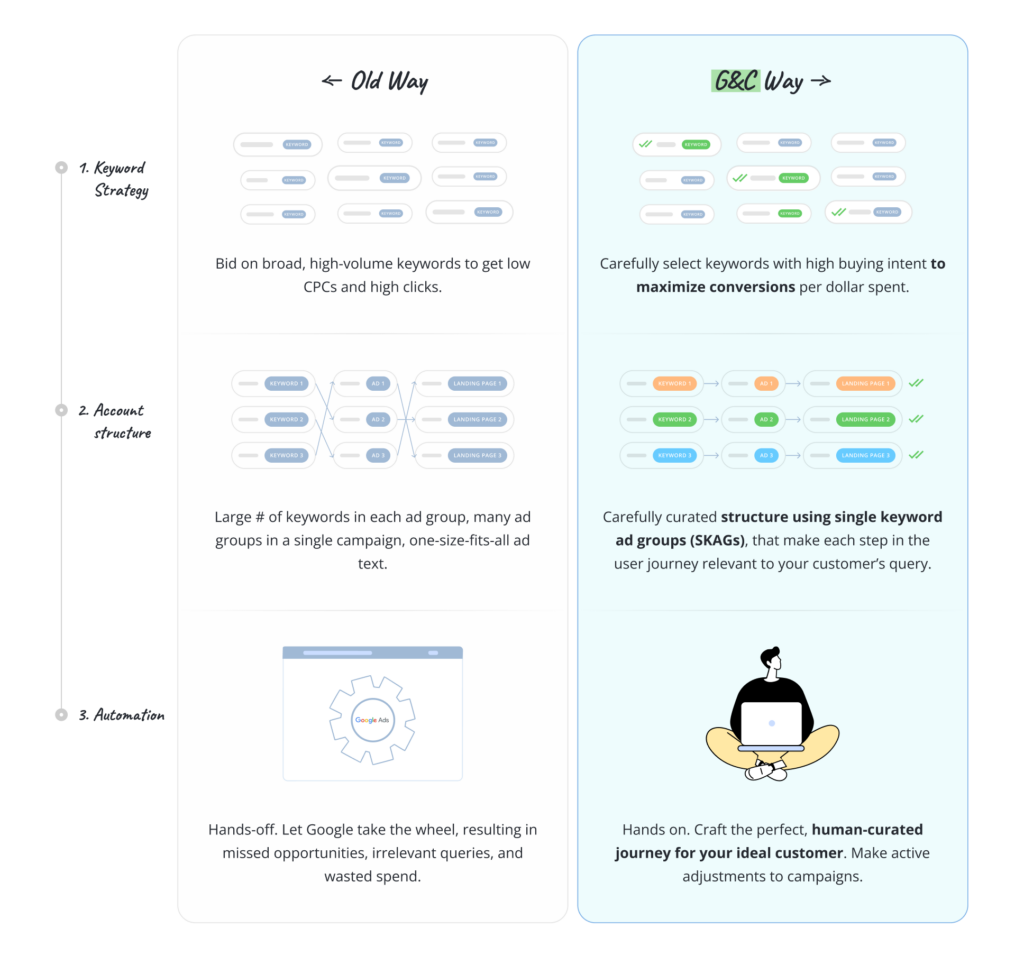We started PPC services at Grow and Convert after seeing thousands of dollars of wasted spend in our client’s Google Ads accounts (full story). Specifically, we noticed that many paid search agencies focus their strategy around maximizing clicks and traffic and rely heavily on Google’s automation tools. In contrast, we applied our well honed bottom of funnel strategy from SEO to paid search, where we take an active, manual approach to ensuring every campaign maximizes lead generation instead of click generation.
Our Strategy and Expertise
Consistent with the SEO strategy we have built over the years (explained below), our PPC strategy centers around campaigns that target your highest value keywords: those that have the most buying intent. Focusing on these keywords eliminates thousands of dollars in wasted ad spend every month. After keyword selection, we structure the account in a way that reduces bounce rates, low click-through-rates (CTR), quality score issues, and, overall, additional wasted spend.

A few ways we accomplish this are:
- Manual, high intent-based keyword selection. Focusing our paid search strategy around manually selecting keywords that are buying-related, rather than loosely related to your product boosts quality lead generation.
- Utilizing only phrase and exact keyword match types. The elimination of the broad keyword match type ensures that the user’s query is more relevant to the keywords we have chosen and the page they will land on, reducing low CTRs and high bounce rates.
- Structuring the account so ad text and landing pages match each query. Without proper account structure, the user’s query may not be related to the ad text (resulting in lack of clicks), or the ad text and query may not be related to the landing page (resulting in wasted spend). We structure accounts strategically so this doesn’t happen.
- Focusing the entirety of spend on Google. Many agencies utilize the Google Search Partner and Google Display Partner networks, which in our experience, wastes a lot of ad budget on low quality traffic that converts at an incredibly low rate.
Applying Pain Point SEO to Paid Search
Years ago, we developed and coined Pain Point SEO, a framework to transform SEO from a solely traffic generating channel into a lead or sales generating channel. We’ve applied Pain Point SEO to paid search as well.
More specifically, in SEO many agencies have a traffic-based mindset that focuses on keywords without any buying intent behind them. In paid search, many agencies utilize keywords without buying intent for reasons like wanting higher volume keywords to max out monthly spend or wanting low cost-per-click (CPC) keywords for “better costs.”, which is misguided since low CPC keywords have absolutely no correlation with high-converting keywords.
You must factor in buying intent to get high-converting clicks from your paid search campaigns. Otherwise you’re throwing ad spend away on clicks that won’t convert.
You can read an extensive article about our strategy written when we first introduced our paid search service here:
Why We’re Adding Paid Search Management to Grow and Convert’s Services
Our Process and Pricing
- We audit your existing ads account
- We identify your highest value keywords and structure your entire account around them: campaigns, ad groups, ad text, and landing pages
- If necessary, we will create landing pages for these keywords
- Once the account is set up and running, we will continue to use our hand-on approach, adjusting anything necessary to make sure the account continues to run smoothly (and bring in leads)
- Provide monthly reporting of key metrics that are important to your business
Cost = $3,500 per month for management in addition to your monthly ad spend budget.
Optional: If you’d only like an audit of your existing account, to tell you what improvements should be made (at no obligation to work with us), we can assist you for a $1,000 flat fee.
Contact Us
To apply for services, or to get more information from us, please fill out the form below.
